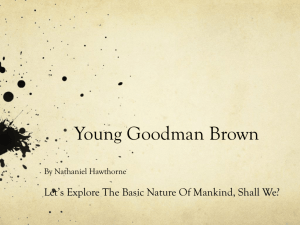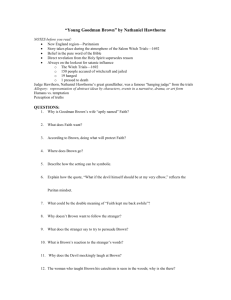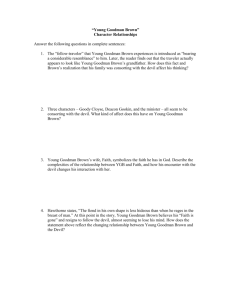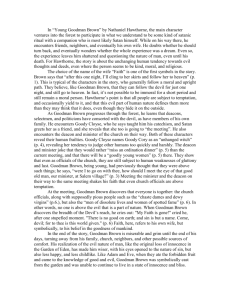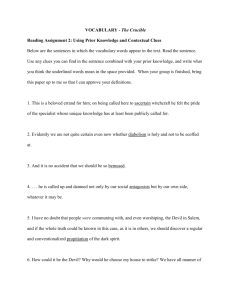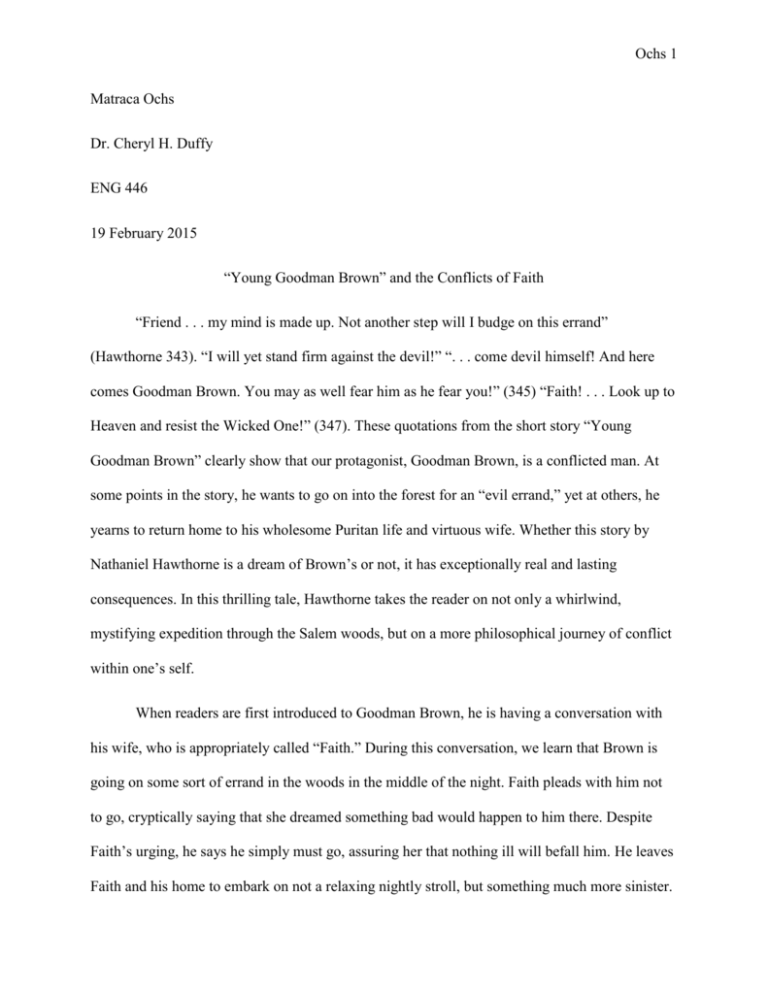
Ochs 1
Matraca Ochs
Dr. Cheryl H. Duffy
ENG 446
19 February 2015
“Young Goodman Brown” and the Conflicts of Faith
“Friend . . . my mind is made up. Not another step will I budge on this errand”
(Hawthorne 343). “I will yet stand firm against the devil!” “. . . come devil himself! And here
comes Goodman Brown. You may as well fear him as he fear you!” (345) “Faith! . . . Look up to
Heaven and resist the Wicked One!” (347). These quotations from the short story “Young
Goodman Brown” clearly show that our protagonist, Goodman Brown, is a conflicted man. At
some points in the story, he wants to go on into the forest for an “evil errand,” yet at others, he
yearns to return home to his wholesome Puritan life and virtuous wife. Whether this story by
Nathaniel Hawthorne is a dream of Brown’s or not, it has exceptionally real and lasting
consequences. In this thrilling tale, Hawthorne takes the reader on not only a whirlwind,
mystifying expedition through the Salem woods, but on a more philosophical journey of conflict
within one’s self.
When readers are first introduced to Goodman Brown, he is having a conversation with
his wife, who is appropriately called “Faith.” During this conversation, we learn that Brown is
going on some sort of errand in the woods in the middle of the night. Faith pleads with him not
to go, cryptically saying that she dreamed something bad would happen to him there. Despite
Faith’s urging, he says he simply must go, assuring her that nothing ill will befall him. He leaves
Faith and his home to embark on not a relaxing nightly stroll, but something much more sinister.
Ochs 2
As Hawthorne writes, Brown feels he is justified to make haste on his “evil purpose,” but also,
that, as Brown says, “. . . after this one night, I’ll cling to her [Faith’s] skirts and follow her to
Heaven” (339-40).
From the story’s opening scene, we come to know that Goodman Brown is a man of
conflicting values. Like many people struggling with their religion, Brown holds the concept of
“one last time.” Here, the reader does not know for sure what Brown’s religion is. However, Rita
K. Gollin, an English professor at New York State University, claims that Hawthorne himself
was a puritan. Furthermore, puritanical beliefs were widespread during the story’s time period
and the setting: 1835, Salem. Additionally, we have no idea of Brown’s past or degree of
religiousness, but by this one sentence he utters to himself, we know that he does believe in some
higher power and wishes to be more god-like and good to go to Heaven. Despite his fear of God
and Faith’s warning of something tragic befalling him, he nevertheless goes on his journey.
The continuation of Brown’s journey defies his wife’s wishes, even though he highly
regards and respects her. Faith is certainly important to Brown, and he curses himself for leaving
her when she is so worried. He even wishes to alleviate her fears about his errand by telling her
that prayers will comfort her as she sleeps. Hawthorne expresses these points by writing Brown
talking to himself as he walks away from the house:
“Poor little Faith!” thought he [Brown], for his heart smote him. “What a wretch
am I, to leave her on such an errand! She talks of dreams, too. Methought, as she
spoke, there was trouble in her face, as if a dream had warned her what work is to
be done tonight. But no, no! ‘twould kill her to think of it. Well, she’s a blessed
angel on earth; and after this one night, I’ll cling to her skirts and follow her to
Heaven.” (340)
Ochs 3
As his conversation with Faith demonstrates, he views her as a wholesome and upright
woman with strong moral and religious values. Perhaps his greatest fear of undertaking this task
is disappointing her, his Faith. Even though he clearly loves her, he does not heed her warnings,
thus illustrating conflicting values and thoughts.
When he leaves his Faith behind and enters the woods, Brown meets an elderly man who
is incredibly similar to himself, “perhaps more in expression than features” (341). This
mysterious familiarity shows that Goodman Brown may be more devil-like than we first
believed. It is also possible that Hawthorne is merely telling us this to help us understand why
Brown trusted him. Regardless of the reason, Brown follows the man into the woods. As they
talk, we discover that this meeting was planned - that it was actually the purpose of his evil
errand.
As the unlikely pair journeys deeper into the woods, we come to believe that this stranger
is actually the devil. Many of his characteristics exemplify this conviction. He has a staff shaped
like a serpent, the most common symbol for the devil. Additionally, the leaves on a tree seem to
wither when he touches them. Furthermore, the most obvious sign of who this man is develops
when he is talking with Goody Cloyse. She proclaims that he is the devil; he replies that she
“knows her old friend” (443). Even though this meeting was planned, as the devil offers Brown
his staff, Brown says he must return home. At the beginning of the meeting, Brown seemed to
want to go with him, but now he is conflicted. The devil bids him to come along, but Brown
continues to refuse. The devil lets him lag behind, seemingly letting him make the choice to go
forward or back home.
Even though Brown protested going forward with the devil, when the devil leaves him,
he is compelled to go forward again. If this action does not exemplify the fact that Brown has
Ochs 4
conflicting thoughts, nothing will. Part of Brown wants to go back to Faith, but something tells
him to keep going forward to see what will happen. If these are the devil’s mind tricks or Brown
simply being overcurious as to what will happen next in the meeting in the woods, Hawthorne
does not tell us. However, we can deduce that, again, Brown is suffering from conflicting
thoughts and feelings about where his faith lies.
As the story progresses, Goodman Brown continues to be in conflict with himself. Does
he keep going or not? Does he turn his back on this errand and be a “good man” from now on, or
does he keep on his journey as one last hurrah? He thinks of turning back many times, but the
devil keeps compelling him to come along either through direct speech or by mystifying actions
such as making Goody Cloyse disappear. According to Mark Canada, an English professor at the
University of North Carolina, one of Hawthorne’s greatest themes is Head over Heart. This
theme certainly runs throughout the story of “Young Goodman Brown.” For example, his heart
compels him to return to Faith, but his head tells him to keep moving forward with the devil.
Ultimately, Brown does not know what he wants to do, but winds up going along with the evil
one, his head winning over his heart for the time being.
To tempt Brown more, the devil says that he is familiar with the deacons of Brown’s
church, and that he has taken communion with them (342). This intrigues Brown even more and
compels him to venture farther into the forest. Additionally, Brown sees a group of men on
horseback also going to the spot where Brown is to ultimately meet with the devil. They are of
the church council, members whom Brown sees every Sunday in mass. Seeing them head into
the heart of the forest while talking of communion with the devil makes Goodman Brown even
more conflicted. These are men whom he believes above all others to be good. They are church
councilmen, one of them even being the deacon. One would think that this would make
Ochs 5
Goodman Brown to begin to trust in the devil: after all, he is consulting with the church
councilmen. However, Goodman Brown is convinced in his assumption of who the man is and
seems to make up his mind once and for all. “With Heaven above and Faith below, I will yet
stand firm against the devil!”(344).
At this point in the story, we believe for one pure moment that Brown will return home to
his wife, his last evil errand be damned. However, Brown is, above all, a conflicted man, and his
faith is fickle. As our newly devout Brown lifts his hands to the sky in prayer, a ribbon flutters
out of where his Lord resides. Brown grasps the ribbon out of a nearby decrepit tree, only to
discover it is a pink ribbon, the same as Faith wears. Even though it is merely a ribbon and not
something so ominous as a trail of blood, this nevertheless leads Brown to believe that his wife is
dead.
“My Faith is gone! . . There is no good on earth, and sin is but a name”(345). Because he
now believes his wife is gone, Brown has nothing to live for nor anything to be a good person
for. By thinking he has lost his wife, Faith, he has lost his faith in the Lord. So, quite literally,
when he lost his Faith, he lost his faith. Additionally, the ribbon being pink symbolizes
innocence. Therefore, as demonstrated in an analysis of the symbols in Goodman Brown, the
pink ribbons abandoning Faith represent her fall from grace and innocence (“Symbol Analysis”).
When he believes Faith is dead, the light in his world has goes out. As a result, Goodman Brown
casts aside his conflict like a ribbon hurled by a strong wind. As this decision occurs to him, he
cries out: “Let us hear which will laugh loudest! Think not to frighten me with your deviltry!
Come witch, come wizard, come Indian powwow, come devil himself! and here comes
Goodman Brown. You may as well fear him as he fear you!” (345).
Ochs 6
This moment is Goodman Brown’s defining instant in the story. He is challenging
everything evil in the world: witches, wizards, even the devil himself. These are the very forces
that puritans are supposed to run from, to shield their hearts and minds from above all else. Yet,
Goodman Brown stands firm, inspiring the devil and evil to come to him. He even goes so far as
to say that they should fear him. At this point in the story, we do not know the mindset of Young
Goodman Brown. He is literally laughing in the face of pure danger, and we are not sure if he is
going to try to take on the devil in some sort of Heavenly duel or join him on his quest to make
all evil and cruel. Despite his reasoning, Brown seems to fly toward the heart of the forest where
the devil is having his so-called communion. Here, we believe that Brown has finally made up
his mind. He will be evil just like the devil at last. His past puritan lifestyle no longer matters.
Faith tied him to his faith, and now that she is gone, what good can there be in the world? How
can there be a God when He allows death to befall the one person Brown felt to be precious?
When Brown arrives at the place in the forest where the un-spiritual union is being held,
he sees many people from his own Church, women and men alike, along with the deacon. He is
surprised to see that so many people are there, and that they have, in fact, been living a lie for so
long. On the Sabbath, they go to church, proclaim themselves as pilgrims of the Lord, and at
night, they commune with the devil. This leads Brown to further believe that there is no good in
the world at all. If so many people, especially those he respects and highly regards, are adhering
to the devil’s words, how can there possibly be a God? Additionally, how can he later go to mass
himself and keep faith in these people, whom he knows are living a lie? Furthermore, Goodman
Brown would be living a lie himself if, after this errand, he went to bed that night, told Faith that
nothing out of the ordinary happened, and attended Church the next Sunday. After all, he has just
Ochs 7
challenged the devil and was thinking about taking part in his evil communion-initiation
ceremony.
Now, we might think that all is lost for our Goodman Brown - that he will join the devil
and his tale will be over. However, when he looks for Faith and does not see her there, he feels
hopeful. Here, again, is when conflict bubbles up into his heart. He was just willing to join the
devil, yet his courage against him slightly rises again now that he does not see Faith strung up a
tree or disintegrating to ashes in a pit of flames. Here, again, is the concept of the duality of the
word and character of “Faith.” When Brown thought he lost his Faith, he lost his faith in God.
Now that he does not think he lost her, his faith begins to intensify.
However, as soon as the devil tells him to step out of the trees and into the woods, he
does so without hesitation. This proves that Brown is still conflicted. Though he is just ready to
give up his religion for the devil, he then decides to keep it because he thinks Faith was still
alive. A few minutes later, he is ready to give it up again directly when the devil calls him.
Towards the end of the story, as soon as Brown is about to enter into the comminution and
therefore adhere to the devil once and for all, he sees Faith and tells her to “Look up to Heaven
and resist the Wicked One!” (347). This part of the story contains an extremely confusing and
long back-and-forth dialogue with Brown’s head and heart always in conflict and never settling
on a resolution.
At the conclusion of the story, Hawthorne leaves it up to us whether Brown’s encounter
with the devil actually transpired or was just a dream, but most readers believe it was, in fact, a
dream. After his “dream,” however, he cannot simply forget what he did and saw in the woods
that night. Brown is haunted by this one evening for the rest of his life. He cannot go to mass
without thinking that the others there are living a lie: “On the Sabbath day, when the
Ochs 8
congregation were singing a holy psalm, he could not listen, because an anthem of sin rushed
loudly upon his ears (348). After all, he saw them making peace with the devil. Additionally, he
can no longer truly partake in prayer himself because he does not believe there is a God
anymore: “. . . when the family knelt down in prayer, he scowled, and muttered to himself”
(348). Furthermore, he even shrinks from Faith, not believing even she, the one in whom he most
believed before this episode, is being honest. By the end of the story, Goodman Brown seems to
have finally ended his inner conflict. He simply will not believe in the Lord or others any longer.
However, there still seems to be this underlying conflict within Brown because he stays with the
church.
Throughout the story of “Young Goodman Brown,” Hawthorne illustrates the ongoing
conflict within our protagonist, but also the bigger and more complex idea of struggle within all
people. Brown’s head and heart were constantly at battle, as all people are at some time in their
lives. However, even though this story ends with Brown becoming bitter with the world and all
that is in it, it does not mean that everyone need follow the same path. We can overcome conflict
in a positive way by simply continuing to believe in ourselves, those closest to us, and our
communities.
Ochs 9
Works Cited
Canada, Mark. “Nathaniel Hawthorne.” University of North Carolina. 1997. Web. 1 Feb. 2015.
Gollin, Rita K. “Nathaniel Hawthorne (1804-1864).” Cengage Learning. Cengage Learning. n.d.
Web. 3 Feb. 2015.
Hawthorne, Nathaniel. “Young Goodman Brown.” Writing about Literature. 11th ed. Ed. Edgar
V. Roberts, 2006. Upper Saddle River, NJ: Pearson Prentice Hall, 2006. 340-48. Print.
“Symbol Analysis of Nathaniel Hawthorne’s ‘Young Goodman Brown.’” WordPress. n.d. Web.
1 Feb 2015.

